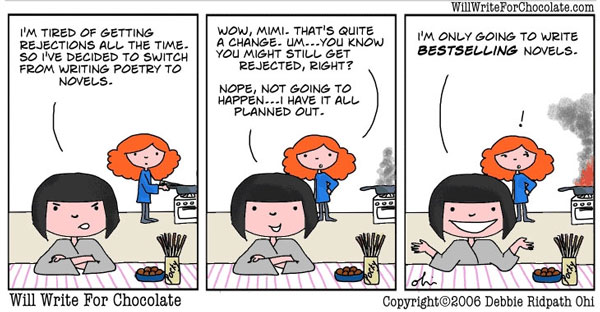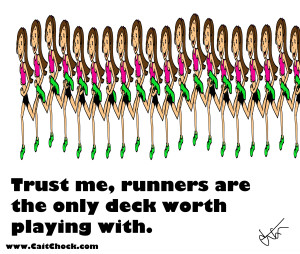Asking my students to set their own goals creates one more opportunity for each of them to be in charge of their learning and reflect on their growth as a writer. ![]()
Viewing: Blog Posts Tagged with: Goals, Most Recent at Top [Help]
Results 1 - 25 of 390
Blog: TWO WRITING TEACHERS (Login to Add to MyJacketFlap)
JacketFlap tags: reflections, goals, writing workshop, Add a tag
Blog: TWO WRITING TEACHERS (Login to Add to MyJacketFlap)
JacketFlap tags: goals, Add a tag
As I looked ahead and began to attempt to set goals for the upcoming school year I realized I needed a plan. What is your summer learning plan? ![]()
Blog: StoryMonster (Login to Add to MyJacketFlap)
JacketFlap tags: storyboards, MonsterBoards, Monstrosities, unresolutions, goals, new years, Add a tag
Right now I’m drawing this in a freezing cold house. It’s freezing cold because the furnace went out, and the company it’s under warrantee with can’t come until Monday.
We’re also experiencing the coldest weather we’ve had in years. (Go figure.)
I don’t mind though because it means I get to sleep in my fridge, which is very warm comparatively. Plus: FOOD!
Did you have a good New Years? Have you already made your yearly unrealistic goals?
Last year I decided to record everything I ate on my phone.
It was the worst week of my life.
The first couple days I did pretty good…until I realized that not eating at all was way easier than logging it in my phone.
So I didn’t eat.
It got to the point where I didn’t want to get out of bed and I was seeing black blotchy things whenever I lifted five pounds or more.
About a week in, I was beat. So much for that goal.
My little sister made that same goal this year.
She’s eaten an apple so far.
I’ve decided that this year I’ll be much more realistic with my resolutions. In fact, I’ve decided to make them UNresolutions–things I won’t do this year.
They might actually get done!
First off, I resolve to quit staring out my window at my neighbors at all hours of the day. (They’ve said it makes them uncomfortable. I think they’re being overly sensitive.)
The same goes for following them around in my car, parking in front of their house and watching them come and leave.
This was one of my favorite pastimes and I’m really bummed about this resolution. (I secretly think they like it when I do this.)
My next unresolution is to not spend a penny on groceries–the whole year!
…And visit my parents more often!
I live about a mile away from my parents. They really love it.
My next unresolution: I resolve to NOT run the presidential candidates and all their little minions over with a giant tank that has poisoned spikes attached to its treads.
This one will be hard. Really, really hard.
And then there’s this unresolution: This year, I won’t buy a little white puppy in a moment on loneliness and then realize I’m always at work and can’t take care of it so I give it to my mom.
This has happened the past several years. (Really.) Sorry, mom. (She loves it.)
I unresolve to never leave my home again.
Ever.
And lastly, I resolve to not set my sofa on fire in a moment of broken-furnace weakness.
This one will be the hardest one of all.
(Time to go make my bed in the fridge).
Blog: ALSC Blog (Login to Add to MyJacketFlap)
JacketFlap tags: organization, goals, Summer Reading, back to school, Early Literacy, Blogger Meg Smith, Add a tag
With our summer reading club winding down tomorrow, August 15th, now seems like a perfect time for us to focus on some new goals as kids return to the classrooms. What ideas do you have to improve your programs, services, and library spaces during this next school year?
Out with the Old
During our busy summer it can be nearly impossible for us to organize everything we need as we scramble from one program to the next. It may not appear as exciting as some of our other tasks, but organizing our offices and closets during this time of transition after summer reading and before the school groups come rolling in can prove tremendously helpful. We complete an inventory of our closets and find some previously hidden treasures that could work perfectly as a prop for story time or an innovative craft. This also helps us save a lot of time when we have things better organized so we can best access our materials, and we use this time to order more supplies to ensure our closets are better stocked when we have those last minute programs we need to put together. Are there any special projects you are taking on to ensure your work space is better organized moving forward this school year?
Examining Our Early Literacy Efforts
Our focus this fall is to streamline our efforts with our early literacy programs and services. Our December youth services training will review the latest edition of Every Child Ready to Read to ensure our new staffers have the skills and confidence to encourage parents and caregivers to participate in early literacy activities with their children at home. We will examine the agencies already available in our community to determine how they provide programs and resources to our children and their families. It is important for us to consider how to reach out to the customers walking through our doors as well as the day cares, preschools, and hospitals we may partner with in order for us to better serve our patrons. What projects or goals do you have to improve your services to your customers as we transition into this new school year?
Summer Reading Brainstorming
As soon as we complete one year’s club, we begin to focus on the next. The ALSC Blog has been a valuable resource for us as we read the creative ideas from librarians across the county interested in innovative ways to increase participation and get children excited about reading all summer long. We will review our prizes and programs to consider how to best reach our audiences next year. When we give our summer reading program the emphasis it deserves by debriefing our previous program and planning the next early in the year, we work to ensure our next year’s program is as successful as possible. It may seem light years away from now, but June and the start of our next summer reading club will be here before we know it. What ideas do you have to enhance your summer reading program for next year?
August is a month full of transitions from one busy season to the next. We will focus our efforts on decluttering our spaces, enhancing our early literacy efforts, and beginning our initial planning for next summer’s reading program. What plans and ideas do you hope to complete during this new school year? Please share in the comments below!
The post A Fresh Start for the New School Year appeared first on ALSC Blog.
Blog: Inkygirl: Daily Diversions For Writers (Login to Add to MyJacketFlap)
JacketFlap tags: goals, Comics for writers, Add a tag

Theresa MacPhail has some great tips for A Realistic Summer Writing Schedule with which you can be productive AND relax.
Blog: TWO WRITING TEACHERS (Login to Add to MyJacketFlap)
JacketFlap tags: writing, goals, habits, Add a tag
Do you need help sustaining a writing habit? Take a lesson from Jerry Seinfeld & "don't break the chain." ![]()
Blog: YA Books and More (Login to Add to MyJacketFlap)
JacketFlap tags: goals, general interest, Add a tag
Dylan Thomas had it right:
"Do not go gentle into that good night...Rage, rage against the dying of the light."
Okay, maybe rage isn't the exact word I'd use for librarians. But the theme of this poem is exactly what I'd use for librarians. It's amazing how fast libraries and our profession has altered in the last 10 years. I remember having a card catalog still available in the school where I started my first job as librarian. (and no, it wasn't in the sixties or seventies either...more like the late 90's).
What Thomas is conveying in the poem is to never give up, never stop fighting the good fight, always move forward and onward despite difficult times. With this rushing tide of change we are part of, when it comes to libraries and our roles in them, this is a theme we must adopt. But it doesn't always mean you have to be on the frontline taking it all in at once.
Moving forward doesn't have a speed limit as long as it continues to go forward. Some librarians have moved quickly and embraced change while others are more tentative, waiting to see how things work, what is going to happen and then act on it. Collectively, we become that tide with change following in our wake.
Last night I was in an exceptional Twitter chat with Angela Maiers where the topic was "#youmatter. When was the last time someone said that to you? When was the last time you said that to someone? So, I'm here to say you DO matter! Not only do you matter, but what you do matters too. Librarians shouldn't be pigeon-holed to a stereotype that keeps perpetuating and the further our profession moves forward, the more we will be valued for what we are today. There should be no excuses, no reasons to not want to be professionally fierce.
And not wanting to change are the difficulties we must rage against, and they are our most powerful enemy. It's time to fight AGAINST dark days and be a part of the battalion who want better than what once was. It's about goals we can make and do our best to fulfill; making and committing to a change (small or large) to make yourself part of the fast-paced change our profession now demands.
Oh, I'm not saying anyone should spend their entire summer working, but we all know that educators take their work with them even when summer break is happening. Asking the "what if..." question and then pursuing it can make all the difference (and that's another poem by Frost for another day :)
Here are a few ideas:
1. Look at your procedures and tweak them to allow more fluidity. It's not about the "stuff" but about the positive relationships you can create.
2. Take a web tool you've never used before and teach yourself through Youtube videos, tutorials on the website, or by Googling how to use it. Make a goal to incorporate this into your library or teach it to a class.
3. Network. More than that, bring in a positive perspective and shy away from those who network and bring complaints. Even if you don't like something, find that one thing that made it good.
4. Read books. Lots and lots of books (or as many as you possibly can). Now take them and share them with your campus however you'd like.
5. Create an orientation presentation for students or new teachers. Delete the facts from the slides (because you're going to tell them) and adapt it to capture attention, not be read.
6. Attend a workshop and make it your goal to accomplish it during the school year, not one you just attended for summer credit.
7. Let someone or more than one know they matter and why.
8. Volunteer to be part of staff development. It can be a variety of ways from offering equipment, helping with information, presenting, creating ideas. The more involved you are, the more you'll be seen as part of the team.
9. Look at the library spaces and see what could be a possibility to accommodate students or classes. Think about everyone's needs, not just a specific audience. Kids aren't quiet by nature...how does this impact the library? How can it be changed?
10. Challenge yourself to be available. Not just behind the circulation desk or your office, but on the floor, in the halls, at events and functions.
Now let's make some waves!~~
Blog: Writing for Children with Karen Cioffi (Login to Add to MyJacketFlap)
JacketFlap tags: perseverance, goal setting, focus, psychological assets, resilience, hope, confidence, goals, optimism, Add a tag
Goal setting, writing goals, marketing goals, life goals . . . everyone has heard of these terms, these strategies to creating and achieving goals. But, what’s involved in actually creating and achieving those goals? How do you get from an idea or desire to its fulfillment? To begin, you need to have the ‘right stuff.’ You need three essential elements. The first of which is confidence. 1.
Blog: Cait's Write... (Login to Add to MyJacketFlap)
JacketFlap tags: running, motivation, art, drawing, goals, facing fears, Sunday Morning Inspiration, sunday morning motivation, Add a tag
Freedom is an interesting thing. We know it’s concept and we get the gist of it all, but many of us are busy functioning amidst our daily routines and we think of freedoms only on their grandest of scale. We are grateful for the rights we have living in a free Country, but we don’t think about the smaller freedoms. The freedoms that our routines, namely being stuck to them, may be stripping away from us.

[From my Instagram]
Routine. Trust me, I’m like you and love a good routine. Routines are good, they keep us focused and working towards goals; consistency is the foundation of every major accomplishment. We NEED certain routines, yet routines are a tricky double edged sword.
Routines keep you focused. Routines can also hold your prisoner. The issues that dictate which is which are: the routine, the basis for it, and how much flexibility you allow yourself within it.
I can parallel this to running because it’s an easy example; training should become a routine. You need to KNOW you’re going to do it, don’t think of it like a ‘maybe’, you know your goals and you know you need to be consistent to reach them. You need that routine to keep you focused because running and training is hard. Frankly it’s painful and there will be times when you need to know you’re going to just have to put your head down and grind through. BUT, there are times when grinding will only leave you a broken, dull stone, so there needs to be a degree of flexibility. There are times when rather than pushing you need to step back.
Freedom outside your routine is also a state of mind. Being so busy usually means you’re perpetually distracted, or so focused on the task at hand you’re not opening yourself up to anything else. PAUSE. A mere pause, and opening yourself up to the possibility of…well, the possible.
You can’t see an opportunity if your eyes aren’t even open. What’s funnier still is that when you’re busily distracted you’re not even aware of the potential that you’re missing something!
That’s not some kind of riddle there, and it’s meaning is only best exemplified through actual experience. If you’ve had a moment where you cognitively shifted your focus, veered slightly outside your routine, and you had a MOMENT, experienced something unexpected that just, made you smile. That momentous experience of freedom is what I’m describing.
You chose to be free and in that moment you opened yourself up to have that smile….however small the experience was that brought it to your face.
You see, to get that smile, that satisfaction, doesn’t require you to veer wildly off course to the point where you recklessly abandon all goals or tasks at hand. No, it can be as simple as putting the other shoe on first…the tiniest change of routine just to show yourself that you CAN do it out of order. Who knows, you may like it. Just knowing you CAN often causes a much larger shift in perspective. You wonder what else you CAN do.
So be free. Think with an open and free mind. I challenge you to do tiny things outside of your routine and see if, by Jove, you like it.
Blog: TWO WRITING TEACHERS (Login to Add to MyJacketFlap)
JacketFlap tags: conferences, goals, writing workshop, Aim Higher Blog Series, Add a tag
So, you've studied your students' writing, analyzing their work for strengths and next steps. Maybe you took home a giant stack of writers notebooks, or a huge pile of on-demand writing assessments, or maybe you've just finished reading their published pieces. Now what?![]()
Blog: TWO WRITING TEACHERS (Login to Add to MyJacketFlap)
JacketFlap tags: Aim Higher Blog Series, family involvement, kidwatching, goals, self-assessment, Add a tag
Blog: TWO WRITING TEACHERS (Login to Add to MyJacketFlap)
JacketFlap tags: writing workshop, Aim Higher Blog Series, editing, goals, Add a tag
Blog: TWO WRITING TEACHERS (Login to Add to MyJacketFlap)
JacketFlap tags: goals, writing workshop, Aim Higher Blog Series, Add a tag
Blog: Cait's Write... (Login to Add to MyJacketFlap)
JacketFlap tags: Sunday Morning Inspiration, sunday morning motivation, sunday morning in, Cartoons, motivation, art, drawing, goals, Add a tag
Blog: Game On! Creating Character Conflict (Login to Add to MyJacketFlap)
JacketFlap tags: goals, scene, Add a tag
Last week, we looked at different options for scene and overall story goals. This week, we'll look at examples that illustrate the theory. Scenes are stonger if the characters involved have opposing goals that create tension. Conflict does not have to be a knock-down, drag-out fight scene.
1. At the overall story level, if Dick wants to marry Jane, the antagonistic forces try to keep them apart. Each scene involves a combination of characters fighting to make it happen or keep it from happening. Friends and foes may have their own goals that help or hinder their relationship. Sally is in love with Dick, so she does everything she can to capture his attention, until she feels forced to kidnap him.
4. Dick might fight to keep a law because it is beneficial to him. Dick and Jane will fiercely debate their sides of the thematic argument with each other and with their friends and foes. They will gain support and lose support. At the climax of the conflict, the law will either be upheld or overturned.
For more information on how to craft believable conflict check out:
For more information on scene goals, pick up a copy of Story Building Blocks II: Crafting Believable Conflict.
http://www.amazon.com/Story-Building-Blocks-II-Believable/dp/1470199998
http://www.amazon.com/Story-Building-Blocks-Believable-ebook/dp/B007SOPXUI
Blog: Utah Children's Writers (Login to Add to MyJacketFlap)
JacketFlap tags: resolutions, Writing, words, goals, Add a tag
I am not a New Year's Resolution type of person. I'm not much of a goal setter, either. Everyone says to make your goals precise and reachable, but when I've done this, I inevitably fail, and then feel like a failure. I don't think that's the point of setting goals, or making resolutions, so I gave up on that. Besides, I'm not a super organized person, so making a resolution in my mind often means I can't even remember it next month, Even if I write it down, I find that I easily forget it. And if I do manage to remember it, by the time I do, the goal has often been revised or circumstances have changed in such a way that the goal no longer even applies.
Here's an analogy from yoga class. Often, the yoga teacher will have each person silently set an intention for the class session that day as we let go of the rest of the world to focus on yoga for this one hour. Usually my intention is something along the lines of "I just want to make it through the class." While I love yoga, it does push my physical limits sometimes, especially when balance or strength are elements of the pose, so sometimes getting through it is all I can hope for.
I feel the same way about life sometimes. Just getting through the day ahead--or the week, month, etc.--is my best goal.
So, I don't do resolutions.
However, my friend and fellow writer, Joanna Marple, wrote this blog post the other day, and it really spoke to me. Instead of resolutions, she suggests we choose a word that we wish to be the focus and intention for the coming year. Hers is serendipity.
I can get behind this kind of thinking. I chose the word EXPAND. In all areas of my life--work, friends, writing, music, travel, cooking, all of it--I can focus on expanding my horizons, increasing the number of new experiences, looking at things in new ways. It makes me think of expanding my mind by reading, listening, and learning. Expanding my circle of people, especially writing people.
This isn't a goal or resolution I can fail at. I can expand my life in so many ways that every day provides opportunities. Maybe it's just a mindset or a mind game, but this feels so much more useful than resolution making. So I'm on it.
If you'd like to join in, feel free to comment with your word and what it means to you. Otherwise, just keep on writing, which is what I'm going to do.
Blog: Cait's Write... (Login to Add to MyJacketFlap)
JacketFlap tags: off season training, tips, running, motivation, art, goals, training, track, races, Add a tag
When you close your eyes, may you dream of lanes, miles, and splits.

It’s never too early to dream of track, or any running goals for that matter. But at a time in the season where your next race may night be quite close enough to ‘taste’…the motivation to brave the elements (Hello, Winter, I was over you last month.) can wane for some runners.
I often take the snarky, or sarcastic, side to life, even when it comes to a ‘kind’ kick in the right direction. Here are some ways I suggest keeping yourself consistent until it IS close enough to ‘taste’ your next race.
1) That Runner Guilt Factor: I’ll be totally honest, this is usually my BEST way to combat a motivation lull. I remind myself that skipping a run usually is not worth feeling that ‘runner guilt’ later. No joke, you know it’s not fun going to bed tossing and turning because you caved to an instance of laziness.
2) The Endorphin Factor: Close to the above, I also remind myself that even if I feel tired/sluggish and the last thing I want to do is run…that usually changes after the first 5 minutes or mile. Once you get into the run those endorphins kick in, and I’ve never finished and thought, “Wow, I really wish I woulda just kicked it on the couch.”
3) Play Antagonizer: Mental dialogue, “C’mon, don’t be a weenie. Suck it the heck up, lace it up.”
4) The Buddy System: When in doubt, call a friend, arrange a run, join a group, social media that you ARE going for a run. That way if you back out, you’ve got to deal with the ‘Tweet of shame’ later. Good peer pressure and all that jazz.
5) Training Program: If you’re training to PR, I have to say I honestly recommend you have a coach, or are knowledgeable enough yourself to coach yourself. But self coaching is HARD…and it’s a lot easier to not have to ‘think’ about your training. That way, you have someone to tell you what to do, BAM, your job is just to run. Trust me, running is hard business, taking some things off your plate is nice. Plus, if your coach gives you the workout, no arguments, lace it up, Buddy!
6) Dream of Goals: Even if race day IS far away, write it down and know your goals. Like the picture above, if you VISUALIZE what you want and put it OUT THERE, it makes things feel more ‘real’ and you know what you’re working towards. It’s harder to blow off a written goal, one you dream about, right? Methinks yes.

7) Bribery: It’ll get you everywhere. Bribe yourself with new running gear, think about dessert, splurge on some cool new shoes, dream of pancakes on your run, create a cool playlist…whatever. When it doubt, donut it out…you just have to run first. ![]()
8) Identity: Okay, some people may be all judgmental and say you shouldn’t DEFINE yourself as a runner…but I’ll be honest, a big part of who I am (or at least the parts I tend to like the most! haha) is that I’m a runner. It’s not just a passion of mine, but it’s a way I connect with people, my friends, and a mentality. I know if I’ve run for the day I feel better and am a happier individual. So race or no race, get my miles on.
9) Money in the Bank: Think of all these miles and workouts as money in the bank. The stronger you are going into the ‘meat’ of the season the better you’ll race. Doesn’t that sound logical? Picture your competitors, who do you think will do better come race day, the ones gettin’ ‘er did, or the sofa’ing ‘er did? The uglier the day/workout, the more excited you should be when you tackle it…it’s making you that much tougher.
10) Superiority: Remember that runners are just better. So go run, don’t you want to be part of the cool kids? ![]()
Snark, goals, tough love to yourself…whatever it takes. Dream of miles, and remember you HAVE the support of the entire (awesome) runner community to give you a motivation boost when you need it.
Blog: TWO WRITING TEACHERS (Login to Add to MyJacketFlap)
JacketFlap tags: writing, goals, writer's block, graphic organizer, character development, Add a tag
Blog: Cait's Write... (Login to Add to MyJacketFlap)
JacketFlap tags: running friends, cross country, tips, running, motivation, training, races, goals, Add a tag
This weekend they will be running the NCAA Cross Country Championships. The pinnacle of excitement for college cross country, I’ve done a few pieces highlighting a few of the front runners vying for the individual title: Shelby Houlihan, Crystal Nelson, and Patrick Tiernan.

Whether you ran cross country in college, or even went to college, or not I urge you to read them because among all of there runs a similar theme: cross country is unique because it blends the individual component of running with the team aspect. As every runner knows, ultimately, a race is against beating yourself, and while track does have a team scoring element, it is in no way like cross country’s.
Here, there is a team of seven, five runners score but don’t think the sixth and seventh man (or runner woman) don’t count. You need all seven because:
1) You never know: We’ve all had days where the gun goes off and it’s clearly not your day. If you’ve got one of your ‘usual’ top five runners amidst a horrible race, you better hope you can rely on your sixth or seventh to step up.
2) The tie: There are classic stories where it comes down to a tie breaker and a win was decided on the number sixth runner…you can bet that runner who proved a win for their team was celebrated that night!
Most importantly, while running is a test against yourself, there is an incredible bond that is formed between training partners. We’ll call is a bond build on suffering, and when you ‘click’ with certain training partners or groups that’s where the magic happens.
A partner, or team, can pull you to YOUR best.
Through the training season, time miles, the work you put in, if alongside a person/team, therein breeds a remarkable enthusiasm. The success of one is a success of the whole, and in the middle of the pain of race day you can dig a little deeper knowing that you’re racing for yourself but also for your team, your friends, the ones who are pushing through their own pain for you too.

Runners graduate, move on, change teams, but the component of having a training partner there to push you remains the same. Out in the ‘real world’ runners have many options in terms of running: solo, with a friend, with a group, finding a team, etc. Each runner decides where running fits into their life and also what ‘kind’ of running they’re doing.
Some crave the solace of a run with no one but themselves, their thoughts, and the pounding of their feet. Ample time for thinking.
Sometimes it is important to be able to grind out a tough workout by yourself because there is an important part of mental training that must occur.
But…I will say if you want to stretch yourself I urge you to try meeting with at least another person for some of those hard workouts. Ideally, a person a tad faster than yourself.
You see, running is ultimately a test against yourself…BUT, it’s because your MIND is (most often) your greatest obstacle. Having another running there ahead of you, giving you chase, is usually just enough to trick your mind into shutting up and letting your BODY prove you are capable of more.
——-
Lots of other new articles on my WRITING PAGE
I don’t update my blog daily but do on my INSTAGRAM and TWITTER FEEDS
To purchase prints of my artwork head to my ART tab! Thank you for respecting the amount of time and creative work that goes into my drawings and not using them without permissions. ![]()
——
1) Did you run for a team ever, be it in high school, college, or beyond?
2) How often do you run by yourself? With anyone else? With a team?
3) Will you make a goal of meeting someone for a hard workout in the not-so-distant future?
Blog: Cait's Write... (Login to Add to MyJacketFlap)
JacketFlap tags: tips, running, motivation, goals, training, facing fears, ask me, Add a tag
Here’s an excellent question I got from a reader recently. If you’ve got any running related questions for me, feel free to drop me a line: [email protected]
Q: Hi,
I came upon your page regarding running and could not help but be very impressed. I am a 23 year old dental student in my final year and the stress of exams has got my anxiety to higher than average levels. I am writing to you regarding advice and techniques on how to relieve such stress/anxiety through the sport of running. I previously ran 5km a day, however due to recent time constraints I have been unable to match this goal. What would you suggest in terms of distance to ensure I do not spend too much time on recreational running? What intensity do you recommend I perform? And finally what supplementation would you suggest to help me improve and relieve said anxiety.
Regards,
Dr. To Be

A: Hi Dr. To be,
Thank you very much for your kind words and I’m happy to hear you’ve enjoyed my site! I’m doubly excited to hear that you’ve experienced just how much of a rush, escape, and release running can be. So much more to running than just the physical benefits it gives us!
Wow, I’m stressed just thinking about all the school and exams you’ve got going over there, congrats on pursuing your degree and making it to the final stretch! Now on to your questions.
It sounds like you were able to become rather consistent and felt comfortable with the 5k a day, but I understand that your schedule is becoming more busy. I’ll offer some tips on ‘finding’ that extra time but in regards to you wondering what the ‘right’ amount of time spent running is, there is not ‘right’ amount for everyone. Running is great because it’s incredibly individual and that means training and racing is all fit to the person, and it’s a matter of discovering what is right for YOU. For some that could be 70 miles per week, for others it’s 20. Always remember that some running is better than no running, so for your situation I’d suggest making a goal to fit in your 5k at least 4-5 times per week. That’s a good amount to make sure you keep your fitness maintained and offer you those times to get ‘out’ of school/stress/work mode and find your escape.
Some tips I have for finding that time:
1) Run first thing in the morning. Sometimes that means waking up a little earlier but it also ensures that no matter what comes up later in the day you’ve got your run done. Take the time the night before to lay out all of your running clothes and shoes so you can roll out of bed and hit the road!
2) Packed and Alarmed. If you can’t run in the morning take a bag packed with all your running gear with you to school and capitalize on ANY free moment you have between classes or find a break. You can also schedule your run time in your day and view it as any other important meeting, it’s YOU time and important.
3) Night Runner. Some people thrive off of running out the stress of the day and like to run at night. If that’s you, instead of Netflix or TV, get some miles.
4) Multitasking. I know runners who do their studying while running, be it flashcards on a treadmill, listening to recordings of lectors or study notes recorded.
Usually there are free minutes in the day, you just have to look for them. ![]()
I also wanted to let you know that the endorphins released from running actually improve creative thinking and problem-solving. Actually taking a break to run when you’re stuck with a problem or project you can’t solve will help your work. When you come back you’ll be more productive and re-energized. So you shouldn’t feel like your running time is ‘wasted’ time that you ‘should’ have been spent studying.
For workouts, if you’d like to push yourself then start by adding some pick-ups, or fartleks, into two of your weekly runs. Make sure you have at least one easy run between them. For some fun workouts, do 1 mile easy, then alternate running 1 minute harder and 1 minute easy. Come back next time and do 2 minutes hard/easy…the combinations for fartleks are endless. I have more workout suggestions HERE.
Lastly, stress management and anxiety. A really powerful tool is visualization, which I wrote about HERE, and you can apply that tactic to all other areas of life. If you’re stressed about exams, then close your eyes and picture yourself arriving to the test area calm, relaxed, and confident. You ultimately want to get in the habit of being able to put yourself into a relaxed state, with steady breathes, and then when the actual event is happening you’re able to recall that feeling of being calm. It take practice and time, but with practice you’ll become better and better at it…just as with running!
Running offers you a unique mind-space; the chemical release of endorphins plus the feeling of freedom, lays the foundation for a happier, more productive mood overall. You may find that some of your best ideas come on the run, that is the case for me! You may also find that over time, and when you’ve got more time in your schedule, you’d like to push yourself by adding more miles and different workouts. As, I hope the relationship you’ve got with running turns into one that is lifelong.
Thank you for writing and happy studying AND running! ![]()
Cait
——
Ask Me: Solving Calf Injuries
Improve Your Running By Asking Yourself THIS Question
Blog: Cait's Write... (Login to Add to MyJacketFlap)
JacketFlap tags: running, motivation, art, goals, training, races, Add a tag
Running takes you away, into another world.
One you control.
Here, time is warped.
Shifted, ticking excruciatingly slower or insanely, much too fast.
Tick. Tick. Tick.
The watch can be a cruel master.
No one can truly see this world…
except for you.
The agony of the inner war waging,
workouts and races, outsiders don’t see.
They don’t FEEL.

But we do. Runners feel,
feel things others can’t imagine…
or would just rather choose not to.
Running’s world is at times painful,
torturous, warped,
but always magical.
Freaking magical…
addictive, alluring.
Control.
Is a finicky world.
In the end we don’t fully control this world,
but merely, the decision of whether to enter it or not.
Drop down the rabbit hole, My Friends.
Blog: Cait's Write... (Login to Add to MyJacketFlap)
JacketFlap tags: running, motivation, art, drawing, goals, Add a tag
You can take running anywhere and you can let it take you everywhere.

Running will open you up to an entire new world…
…a new community. Friendships, relationships, instant connections. “I’m a runner too.”
The lessons you learn as a runner apply to all areas of life. It will make you stronger.
Physically. Mentally. Emotionally. Tougher.
Being a runner means you will DREAM. Not with eyes closed, but rather with eyes squinted thought beads of sweat.
Running will take you to new places both literally and metaphorically. It will SHOW you new places within yourself.
Oh, that places you’ll run. #ohtheplacesyoullrun
——–
UPDATE!!! Do not fret, the Arty Runnerchick is still alive and kicking. I’ve been working on quite a few exciting projects which I will be sharing with you soon!
While that means I haven’t been able to update the blog as frequently as I’d like, I AM updating my INSTAGRAM page daily…so be sure to follow me there to catch everything there first! I’m also on Twitter ![]()
In case you’ve not checked it out, I’ve got new articles published on the WRITING page, particularly a lot under the RunBlogRun section.
There is also new art available on the ART page.
Keep running, My Friends, and talk soon!!
Also be sure to SHOP EZZERE! ![]()

Blog: Life, Words, & Rock 'n' Roll (Login to Add to MyJacketFlap)
JacketFlap tags: Writing Process, goals, Dutton, Hugo House, Rookie, zine-style memoir, non fiction, Add a tag
- It’s just as emotional, if not more emotional to write. I write intense books. If you’ve read them, you know that. I deal with heavy shit like addiction, abuse, sexual assault, depression, self-injury and I don’t pull any punches. The reason I write so honestly about these things in my fiction is because these are the stories I needed to read as a teenager. And why did I need to read them? Because I was going through all of that shit. And now my job—the one I signed up for in some moment of total insanity (kidding… sort of)—is to rehash all of that very real shit that I went through. Now I’ve been doing this for a while in my essays for Rookie, but now I’m spending all of my writing time doing that, which is not exactly fun. I mean, I knew what I was getting into, and for the most part, I’ve processed all of this stuff in therapy (and through writing fictional versions), so it hasn’t been too detrimental to my emotional well-being—my revisions on BALLADS were actually much worse… at least, so far. BUT when you get up at 5:30 am to write and/or you spend most of your Saturdays writing like I do, it can be… unsettling. I went to a party on Saturday night after writing all day and it took me a couple hours to pull myself out of my own head. And some days I get to work and just feel anxious and tightly wound all day for no reason—except I spent the first hour of my day recounting a horrible fight with my childhood best friend. So yeah, it’s emotional work and I expect that it will get harder.
- This is what research looks like:
Yeah, those are my diaries. Clockwise from the top, they are from grade school (as you may have guessed from the pink kitty), 8th grade, summer before and all of junior year of high school, the two composition books are from my senior semester of high school (I took a journal writing class and I had A LOT to say, so much that when I filled them, I went back to black-and-white cat journal and finished filling it during the rest of what would have been my senior year when I was living on my own in Madison, Wisconsin), and the last journal is from my year at Antioch College and the two years I lived in Madison after dropping out (I was the opposite of productive then). Conspicuously missing are 7th grade (that was a very bad year and I tore my journal—also a Star Trek log book—to pieces, and I think, flushed them down the toilet) and freshman and sophomore year. That was a green spiral bound notebook. My abusive boyfriend demanded to read it in my sophomore year, so I ripped out a bunch of pages and REWROTE THEM. I’d saved the ripped pages and tried to reassemble/rewrite the whole thing on a couple of occasions, but since I never did it all, this led to confusion later about what was real and what wasn’t and eventually I threw the whole thing away. It kind of sucks because my memory is imperfect and these diaries (along with calls to my mom, who usually is my medical resource for my novels) are the easiest way to jog it. Well, easiest in terms of remember what happened when. Re-reading them is actually horrible. Like when this book is done, they might all go in the trash. And no, this isn’t me being critical of my writing skills (those aren’t actually that bad), this is because of my worst discovery about memoir-writing so far, which is… - Writing about yourself sorta makes you hate yourself. I cringe every time I flip through any of those old diaries (aside from maybe the grade school one—not that I can flip through it because I thought what I’d written was so damning, I tore the pages out and stuffed them in an envelope addressed to my cousin presumably because I trusted her to dispose of them in the unlikely event of my tragic demise). The 8th grade one is pure obsessive love. Yeah, it was my first crush. That’s probably normal to a degree, but holy shit is it embarrassing. I thought I was going to marry this guy and have three babies (the Ouija board told me so). I thought I was gonna die when he asked another girl to the graduation dance. It includes other things I’d rather not recall either like when I got into Pearl Jam just to impress my best friend’s new friend. I hate Pearl Jam, but boy did I convince myself that I loved them, just to fit in… at a time that I swore I was done trying to fit in.
The obsessions and the hypocrisies are the worst and they continue through all the journals. I’ll blast girl for spreading rumors and “girl hate” while saying the most awful, hateful things about her. And during the fucked-up relationship from my late teens there are actual entries written in my own blood. The worst of the worst though is from the summer between sophomore and junior year right after my abuser and I broke up when I was still in love with him and that period after I realized what he’d done to me, but I still loved him. Of course the anger that followed was not any easier to stomach.
Basically reading these diaries forces me to revisit the weaknesses that I hated most about myself and also forces me to look at how self-centered and cruel and angry and awful I was at times. I have to recognize that I was not always a good person and I made A LOT of mistakes. Of course this book is about identity and how the many pieces of us come together to form something whole (or mostly whole). I thought I was writing about that in a retrospective way, but I’m realizing now that there is still going to be some self-understanding and self-forgiveness that is going to have to come from the writing process. And while I’m in the thick of it, I’m going to have to remind myself that I’m not that person anymore and I learned from both her good and bad decisions and traits. - Just because my life has an arc or a “plot” doesn’t mean I’m not going to have to make major structural decisions within each essay/chapter and for the book as a whole just like I would for a novel. This has been my biggest writerly problem so far. I sold the book on proposal and I thought I had a solid idea of what it would be—more like a collection of essays than a memoir. But as soon as I started writing in earnest, I realized it wasn’t really working. I can’t just plug this essay fromRookie about my struggle with self-injury in to the place where it seems to fit best chronologically—junior high because that’s when the cutting started—because the essay covers my whole journey, from twelve to twenty-two or twenty-three. Reading that and then reading the next thing about me being fourteen and struggling with self-esteem or something, it’s jarring. It doesn’t flow as a narrative. It makes you feel like fourteen-year-old me should be better off because she was at the end of that last piece (even though she was also in her twenties). My editor noticed this, too, of course, and we talked about it for an hour. I have ideas about how to fix it, but the structure still feels very murky right now. That seems to be happening within each essay/chapter I write too. I start off one way, then change my mind, then end up with alternate versions of each piece. It’s frustrating and I don’t want it to be. I know that if I agonize over structure now, it’s going to really slow me down and it’s all going to change later. So this has led to…
Blog: Cait's Write... (Login to Add to MyJacketFlap)
JacketFlap tags: tips, running, motivation, art, goals, nutrition, injuries, training, cross training, Add a tag
Within every runner live the Yin Yang twins…the grinder and the ice-cream loving, sloth who lives to watch cartoons. We’ll call the latter the ‘recovery champ’.

While I jest, because it’s not just ice cream they love but pizza, donuts, burritos, french toast [insert runger fantasies here], there is truth to it.
In order to run hard you’ve got to allow your body to recover just as ‘hard.’ It often takes runners awhile to learn this, often the hard way. Typically everyone goes through the stage where they race every run, a run doesn’t count unless you’ve maxed out, right?! ![]() While this usually leads to improvement in the short term, eventually going hard every day will lead down the road of an injured, over-trained, mess.
While this usually leads to improvement in the short term, eventually going hard every day will lead down the road of an injured, over-trained, mess.
Without adequate recovery you’ll be too tired to actually run fast. Easy days are important, as are other ways to speed up your recovery. In order to NAIL the days that count, your hard workouts and races, you’ve got to ensure your muscles are able to rebuild and repair themselves between hard sessions.
So there IS an excuse to laze around in your sweats and hit up a Netflix marathon. ![]() Recovery is more than just an easy day too, for most mortal runners of the world running isn’t your job so lifestyle choices and how you spend the non-running hours of your day will play a big role in your ability to recover.
Recovery is more than just an easy day too, for most mortal runners of the world running isn’t your job so lifestyle choices and how you spend the non-running hours of your day will play a big role in your ability to recover.
Even for the elite runners, they are continually looking for ways to improve their recovery…because chances are there is ALWAYS room for improvement somewhere.
Take a look at your own habits and look for areas you know you could be better at. I’ve made a handy little checklist to give you some ideas of where to start:
* Make sure your easy days COUNT: rely on effort, don’t wear a watch if you have to, you should be able to hold a conversation between breathes on these runs.
* Proper Workout Scheduling: every runner needs to learn their body and how many hard workouts they can handle in a week. As we age we need to learn how to adjust, that may mean turning your ‘week’ into a 10 day cycle.
* Cross Training: I did a whole post HERE about how to maximize training if you know your body can’t handle too many running miles. Cross training on your easy days or as a ‘second run’ can help keep you healthy and allow for an ‘easier’ workout for recovery purposes.
* 30 Minute Refuel: eat a combo of protein and carbs IMMEDIATELY after your runs…especially your hard workouts. Miss this window and recovery rates drop upwards of 60%.
* Nutrition: eating to perform means opting for quality foods, timing them around when you run, and ensuring you get enough nutrients. This means protein, carbs, healthy fats, and overall enough calories to fuel your training demands. Eating to perform also means LIVING, if you’re training hard enough and want a freaking donut, you’ve earned it. Balance comes into play, so I’ll use the analogy of a silo. Fill your body with all the quality nutrients first, then any extra ‘energy demands’ needed to fill the rest of the silo should be up to you. A world without french toast is a dark one.
* Self massage: whole post on that HERE, flush out that lactic acid, keep your body knot-free.
* Hydrate: this is incredibly important regardless of the season, obviously hotter weather requires you to hydrate more and with electrolytes but even in a snow storm you’re losing moisture. Drinking after massage is also important to flush out all that ‘junk’ worked out of your muscles.
* Stretching: tied into self-massage, stay loose, limber, and avoid injuries.
* Time on Your Feet: it’s draining on your legs and energy-zapping, if your job requires you to do lots of ‘work’ know that you may need to adjust your training or learn how it affects you.
* Time on your butt: yea it’s important to rest, BUT office jobs can lead to problems too…too much sitting leads to weak glutes, tight hamstrings, and reduced blood flow. Not good for recovery, so be sure to move around and at least walk around a bit between Netflix marathons.
* Sleep: while I may leave this one for last, this is HUGE!! Sleep is when the body REALLY restores and repairs itself. Skimping on sleep will hamper your recovery, professional runners guard their sleep time and usually take naps too. Make sleep a priority. For those with sleeping problems and insomnia (ugh, join the party!) look for ways to improve the situation or figures out what can sometimes help. Restless nights add up to tired legs and eyebags. ![]()
I think that’s a solid list of ways to improve your recovery habits. Start cracking! To let that grinder perform at it’s best, that recovery-er needs to be doing it’s job right too! ![]()
—–
New ART is listed and available for prints on my page there…restructured to make things a little easier. As always, anything not shown, email me a request and I’ll get you a print.
—-
1) What are some ways you make recovery a priority?
Blog: Cait's Write... (Login to Add to MyJacketFlap)
JacketFlap tags: tips, running, goals, training, cross country, workouts, hill running, treadmill running, cross training, Add a tag
Runners are constantly climbing. It’s in our nature to always have a goal we’re working towards, always wanting to push ourselves to do better. Whether it be chasing new PR’s, challenging yourself to expand your race distance range, or even after we’re past our ‘PR-PR’ years, redefining the times and bests (weekly, yearly, masters, etc.) bests.
Diversity. Fitting as it is now cross country season that we talk about diversifying your running and climbs. Cross country thrives on both. I’ve done posts on just how awesome hills are at improving your strength and power, which translates to speed. What I haven’t talked too much on are prolonged hill climbs.

The long climb, yup. We’re talking taking your tempo runs to the trail, or inclined treadmill if you don’t have a stretch long enough outside. I’ve previously featured the man-beast that is Michael Wardian and he’s no stranger to treadmill running.
While he’s one of the World’s best ultra and trail runners, a major chunk of his miles are done on the treadmill so he can fit his runs in around his family’s (namely his kids’!) schedules. Wardian loves a good, long climb.
He makes sure to do hill work a few times a week and, “for me that means hours of running up vertical inclines, sometimes fast, sometimes just a long grind, but always pushing to get better.” Wardian is an ultra runner after all.
Another big fan of prolonged uphill runs is Sage Canaday, a staple workout for him is an uphill tempo run. Canaday is another World leading ultra runner [check out my feature on him HERE], residing in Boulder, CO he has no shortage of trails to mountain goat up.

Yo, that’s my rockstar dad running 50 miles! :)
Even if you’re not one of the best in the World, taking advantage of prolonged hill climbs will benefit you. Coach Brad Hudson of the Hudson Training Systems, coaching both elites and all levels of runners, regularly incorporates uphill tempo runs for his runners.
Try It:
Take your next scheduled tempo run to a hill, keep the distance the same and adjust based on effort. [Captain Obvious: Your times aren't going to mean much, so go off of effort.] I’d suggest going 4-5 miles.
No hill? No problem…take it to the treadmill. For a moderate climb set the grade to 4% for your tempo run and again, go off of effort. Do your warm-up and cool-down at 1.5%, as that’s the equivalent to running outside on the flats…after you jack that incline up and finish your tempo run, upon lowering you’ll see just how much ‘easier’ the same pace will feel at 1.5%!
If you’re looking for a steeper incline, Captain Obvious tells us you can just elevate the treadmill. ![]()
Another twist courtesy of Coach Hudson would be to make your hill climb tempo progressive, begin the workout at a 2% grade and have it up to 6% by the time you finish.
Life’s a climb after all. For runners, we take that both figuratively and literally. ![]()
——–
More workout posts HERE
Need some motivation to get ‘er done…look HERE
Sweat hard, recover hard… #SweatsintheCity style, Baby!
——–
1) Are you running cross country season?
2) How do you incorporate hill work into your training?
3) Have you done incline tempo/threshold work?
View Next 25 Posts






















